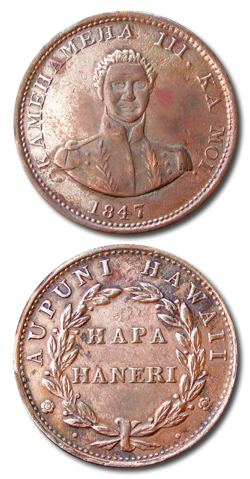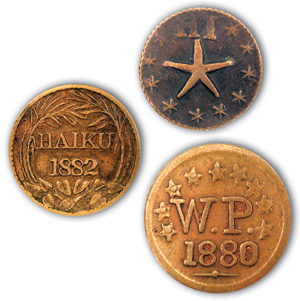|
"Making Cents"
The Signal
Saturday, October 28, 2006
| M |
In 1847, King Kamehameha III issued one-cent coins the size of United States copper cents. About 100,000 were minted, and they circulated for the rest of the century alongside many types of foreign coins.
The Kingdom of Hawaii did not have a mint nor the metals needed to mint coinage, so as long as there was an adequate supply of coins from Spanish American colonies, Asia and the United States, commerce relied on a mishmash of coinage to get along.
Various tokens issued by several plantations, including the Wailuku, Thomas Horton, Waterhouse and Haiku, served as minor coinage along with foreign coins. These tokens, all of which are quite rare, were valued in either Spanish denominations such as "half real" or U.S. denominations such as "35 cents."
These tokens were issued from 1860-91, and many were dated the year of issue. Today the few remaining specimens catalog from $550 for a Horton 12-1/2 cent token of 1879 to $1,500 for the 1860 Waterhouse token.
In 1883, under King Kalakaua I, Hawaii contracted with the United States Mint in San Francisco to produce coins of the same size and fineness (.900 silver) as the current United States coins in the denominations of 10 cents, quarter dollar, half dollar and one dollar. These coins were the official coinage until 1900, when the United States annexed the Hawaiian Islands after the Spanish American War. A five-cent piece dated 1881 was minted but never authorized, and the few known specimens catalog for $25,000 in mint condition.
A pattern 12-1/2 cent coin was designed, and only 20 were minted in proof condition. These pieces catalog for $65,000 and rarely show up in major coin auctions or estates.
The most common of the 1883 coins, the quarter, catalogs for $65 in fine condition and $275 in mint condition. The dime is the next most commonly available coin and catalogs for $70 in fine condition and $1,500 in mint condition. The silver dollar catalogs for $400 in fine and $4,500 in mint condition — although MS-63 (choice uncirculated) specimens catalog for $11,000.
|
In 1900, the legal status of these coins (and all other foreign coins in Hawaii) was revoked; all such coins that passed through the banks and post offices were removed and melted. Fortunately for collectors, enough survived.
The late Dick Yeoman (original author of "The Guide book of United States Coins," aka "The Red Book") found a Hawaiian silver dollar about 60 years ago made into a colorful enameled love token which his wife wore at many coin shows as a pendant on her necklace. Many of the quarters were also made into love tokens or engraved coins.
Around the 1960s, souvenir shops in Hawaii started selling replicas of the one-cent piece of 1847. These are made of brass (not copper) and often have inscriptions different from the original coin.
At an estate sale of coin collector Bill Braithwaite at the Orange County executor's office some years ago, one of the lots was one of these tokens, and the catalogue simply listed it as "Hawaiian One Cent 1847." The unlucky bidder paid $75 for a token worth 10 cents.
The coins and tokens of Hawaii are not sold in souvenir shops, and if any show up at an estate sale, let the buyer beware.
Dr. Sol Taylor of Sherman Oaks is president of the Society of Lincoln Cent Collectors and author of The Standard Guide to the Lincoln Cent. Click here for ordering information.
©2006, THE SIGNAL · ALL RIGHTS RESERVED.

![[Most Recent Quotes from www.kitco.com]](http://www.kitconet.com/images/quotes_special.gif)


